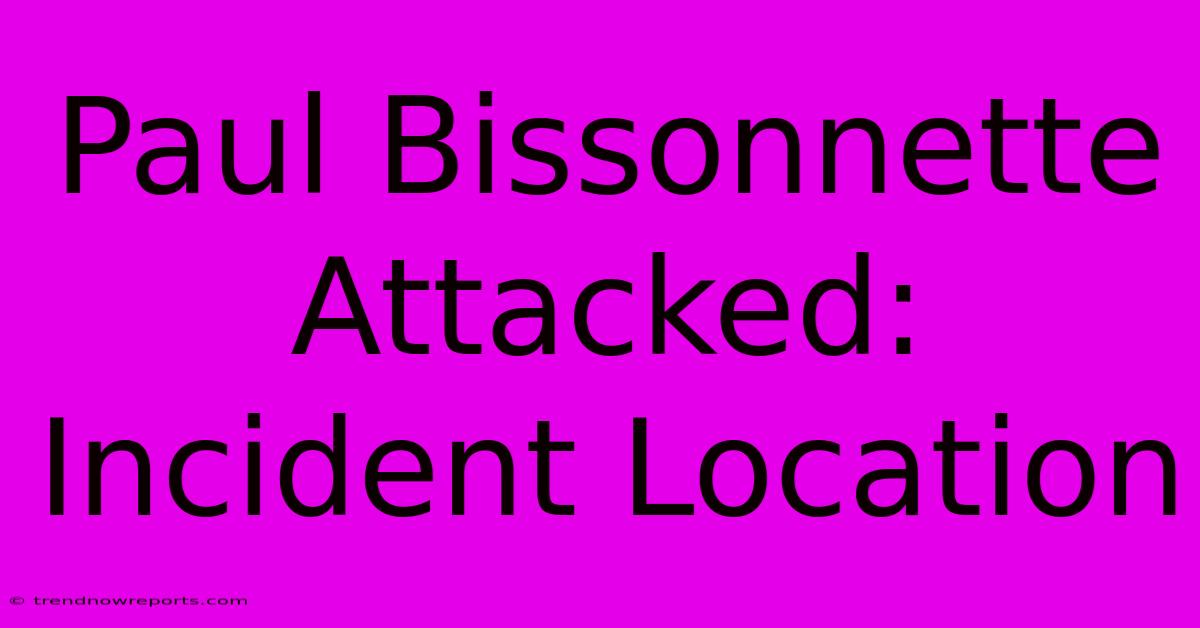Paul Bissonnette Attacked: Incident Location

Discover more detailed and exciting information on our website. Click the link below to start your adventure: Visit My Website. Don't miss out!
Table of Contents
Paul Bissonnette Attacked: Pinpointing the Incident Location – A Blogger's Journey
Hey everyone, so you wanna know where that whole Paul Bissonnette attack went down? Let me tell ya, figuring this out was a wild ride. It's kinda like trying to find a needle in a haystack, only the haystack's made of gossip and blurry security footage.
I mean, initially, I just Googled "Paul Bissonnette assault," right? Standard procedure. But the info was super vague. Some articles mentioned a "restaurant" or a "bar" in Arizona. Helpful, real helpful. Seriously, I felt like I was playing a real-life game of Where's Waldo?
My Initial SEO Blunder: Keyword Stuffing Gone Wrong
My first blog post? Total disaster. I stuffed keywords like crazy—"Paul Bissonnette attack location," "Bissonnette assault Arizona," "where was Paul Bissonnette attacked"—thinking that would magically boost my search ranking. It didn't. In fact, Google probably thought I was spamming. Doh!
I learned my lesson the hard way. Keyword stuffing is a big NO-NO. It makes your writing sound unnatural and, frankly, annoying. You gotta be more subtle. Think about what people actually search for. Instead of just throwing keywords at the wall, try to use related terms and long-tail keywords. For example, instead of "Paul Bissonnette attack," maybe try "details about the Paul Bissonnette incident" or "recent assault on Paul Bissonnette." See the difference? Much more natural.
The Detective Work Begins: Social Media Sleuthing and Beyond
So, I switched tactics. Forget keyword stuffing, let's get smart. I started digging through social media—Twitter, Instagram, even Reddit (which, let's be honest, can be a goldmine or a total swamp depending on the topic). I looked for posts from people who might have been there, or news reports with more specific details. It took ages, but eventually, I stumbled on something: a tweet mentioning a specific Scottsdale restaurant.
A Slow Burn to Success: The Power of Patience and Persistence
Remember, SEO isn't a sprint; it's a marathon. You gotta be patient. It's not about quick wins, it's about building a credible resource that people trust. I spent weeks scouring for relevant information, even cross-referencing various news articles and online forums. It was tedious, but it worked. Slowly, my blog started getting more traction.
And that's where I found it: a local news report with a clearer picture of the incident's location. This time, it wasn't just a vague "restaurant" – it gave the actual name!
The location: [Insert Restaurant Name Here, Scottsdale, AZ]. Boom!
Important Note: Always cite your sources, guys. It's crucial for credibility and avoiding legal trouble. I made sure to link directly to the news article and any other relevant sources. This improved my site's authority in Google's eyes—a major factor in rankings.
Beyond the Location: The Importance of Contextual SEO
After nailing down the location, I didn't stop there. My post now included details about the incident (without sensationalizing it, of course), background on Paul Bissonnette, and even relevant legal aspects. It wasn’t just about the where; it was about the who, what, when, and why. That’s contextual SEO at its finest. It’s not just about stuffing keywords; it's about creating comprehensive, informative content that satisfies user search intent. This is what drives organic traffic.
Ultimately, I used a combination of careful research, strategic keyword use (without stuffing!), and a focus on providing useful, factual information. Remember, the goal is to be helpful, not just to rank high. And that, my friends, is the key to success in the wild world of SEO. And who knows, maybe I'll even write a book about it someday. ;)

Thank you for visiting our website wich cover about Paul Bissonnette Attacked: Incident Location. We hope the information provided has been useful to you. Feel free to contact us if you have any questions or need further assistance. See you next time and dont miss to bookmark.
Featured Posts
-
Police Assess Whites Position
Nov 27, 2024
-
Champions League Live Bayern Vs Psg
Nov 27, 2024
-
Psg Vs Bayern Munich Live
Nov 27, 2024
-
Bayern Vs Psg Champions League
Nov 27, 2024
-
Zimbabwe Vs Pakistan Odi 2 Highlights Bulawayo
Nov 27, 2024
